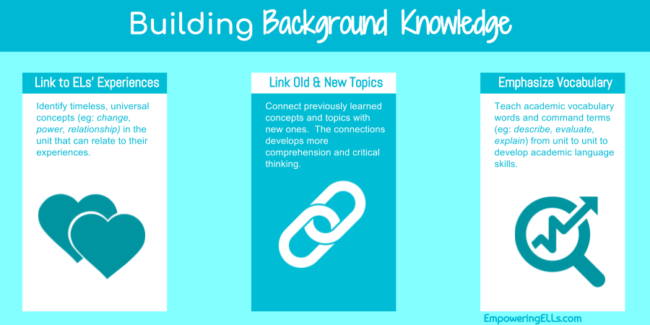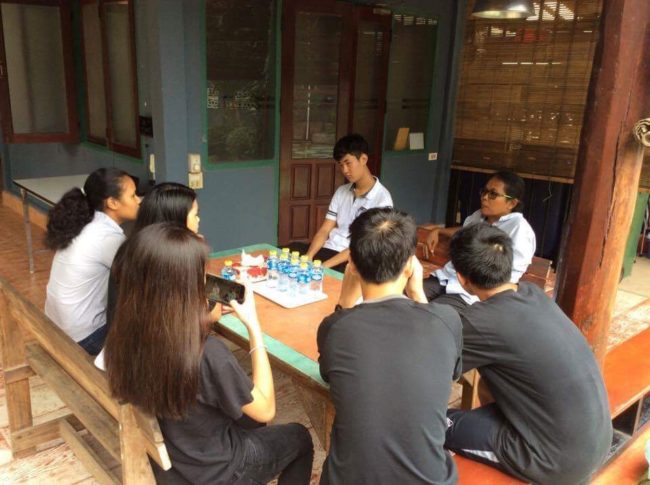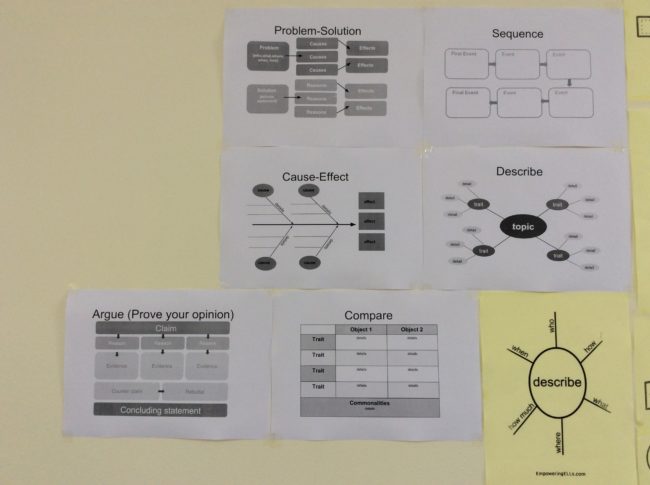Building Background Knowledge Sheltered Instruction Observation Protocol
Some people like surprises, like when someone throws you a surprise birthday party. But in education, surprises tend to leave ELs confused, not energized. There's no context for learning the new information and nothing for them to tether current learning to past experiences. Before surprising your ELs with new information, building on their background knowledge helps provide solid ground for them to build on new knowledge.
In this third article in the Sheltered Instruction Series, I share the key points of building background knowledge.

Building background knowledge is so important that it is considered a key component of sheltered instruction. In Making Content Comprehensible for English Learners: The SIOP Model (5th Edition) (SIOP Series) , Echevarria, Vogt, and Short recommend three things when trying to establish background knowledge :
- Explicitly link concepts to students' background experiences
- Make clear links between past learning and new concepts
- Emphasize key vocabulary terms (2017).
(Side note: If you happen to purchase this book, it supports the blog).
Explicitly link concepts to students' background experiences
I'm currently teaching a 10th grade English unit around the concept of heroes. Because this was the first unit of the year and because I didn't know my students in this class, it was difficult for me to connect to their background experiences.
Instead, I had students connect to the universal concepts in the texts we viewed.
For example, we read The Hunger Games to start exploring this concept of heros. As we read, we identified other concepts such as:
- Control
- Sacrifice
- Family
- Service
- Community
By looking at this list of universal concepts , students could easily find personal experiences that connected to these concepts. For example, Vina connected to the concept of control by explaining how her parents control her in different ways and to different degrees. She then analyzed how the Capitol controls the districts in different ways, the cruelest of which is by creating the Hunger Games.
Allowing ELs to connect to concepts in this way:
- Values what ELs bring to class as assets,
- Fosters greater comprehension of content and
- Develops ELs' critical thinking skills
Make clear links between past learning and new concepts
Because this was the first unit of the year, I didn't have any prior units to connect new concepts to past learning. Instead, I decided to connect concepts between the resources used in our text set , which included:
- CNN Heroes videos
- Articles associated with the CNN Heroes videos
- Visits to two social enterprises in Laos
- A New York Times article on N.F.L. players responses to President's Trump Tweets .
We started by watching and reading articles related to Thistle Thorns , a social enterprise that supports women escaping from prostitution, trafficking and drug use. Students identified several concepts from these resources (ie: service, compassion, abuse, escapism, seeking belonging).
The next class, we went to visit a Lao-based social enterprise called Xao Ban . Students toured the facilities and interviewed Ms. Nongnut, the founder, to learn how one might consider her a hero. Once back in class, they had a Harkness ( student-led discussion ) to compare the concepts from Thistle Farm and Xao Ban. 
Though these two social enterprises were different in many ways, students were able to identify concepts that were similar to both. We didn't just move from video to article to field trip. Instead, we purposefully returned to the previous resources to make sense of the current resource.
Emphasize key vocabulary terms
Lacking proficiency in academic vocabulary is one of the main reasons why many ELs experience the fossilization of their English skills . It also significantly impacts their achievement because ELs are not able to access academic text or communicate using academic language.
In my unit on heroes, I emphasize key academic command terms , such as:
- Describe
- Sequence
- Compare
- Cause-Effect
- Problem-Solution
- Argue

Then, I make sure the assignments we have circle back to and reinforce those vocabulary terms. One way to do this is by brainstorming writing topics for homework based on the resource we reviewed in class. The topics themselves need to use one of these key academic words. For example, after reading the New York Times article about N.F.L. players' responses to Trump's tweets, students identified three writing prompts they might explore further in writing:
- Describe the conflict between President Trump and some NFL players.
- Compare NFL players with the characters in The Hunger Games.
- Argue your opinion about how the NFL players are protesting Trump.
I know what you're thinking: These aren't words related to the Heroes Unit! But our priority should be helping ELs develop academic language proficiency , not just learn content for one unit. By integrating these terms in the lesson, ELs understand them when they're expected to:
- describe a phenomenon,
- sequence events,
- compare ideas,
- describe the cause-effect relationship,
- identify a problem,
- suggest a plausible solution or
- argue a claim in there other classes.
Takeaways
Surprises can be unpleasant, but we can make learning experiences less surprising by building background knowledge between new content and students' experiences. These three ways to build background knowledge bridge this divide. Without them, it's certain that some students will be left behind by the divide in experiences, while others forge on ahead.
Echevarria, J., Vogt, ME, & Short, D. (2017). Making Content Comprehensible for English Learners: The SIOP Model. Fifth Edition. New York: Pearson.
Nora, Julie, and Jana Echevarria. No More Low Expectations for English Learners . Heinemann, 2016.
Building Background Knowledge Sheltered Instruction Observation Protocol
Source: https://www.empoweringells.com/building-background-knowledge/